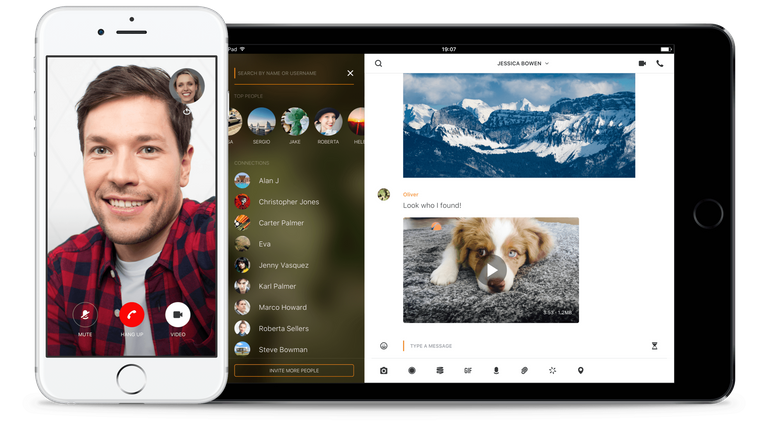
In 2013 the world found out, through whistleblower Edward Snowden, about a massive global surveillance system that had been set up and run by the US National Security Agency. Judging by the classified documents that Snowden released, the NSA grabbed just about everything it could as it traversed the Internet: emails, faxes, video and audio chats, and even watched players in online games like Second Life and World of Warcraft. Nothing was out of their reach it seemed as, in 2013, very little of the Internet was protected by encryption. Honestly, many of us just never thought we needed it.
Since then, a massive uptick in the use of encryption over the Internet has happened. More than 60% of websites now use TLS, most chat programs encrypt messages in transit, and it's generally become a lot harder for the NSA to slurp up traffic. On the communications front, an entire crop of new instant messaging and calling applications have sprang up, each guaranteeing the privacy of your communication. While many of these applications have proven to have serious vulnerabilities that did little to protect their users conversations, two have emerged that have show real promise: Whisper Systems Signal and Wire Communications Wire Messenger. Today, we're going to take a loot at Wire Messenger.
Introduction to Wire Messenger
Wire Messenger is a relatively new cross-platform instant messaging, voice, and video calling application created by Wire Swiss GmbH. It runs in your web browser, on the Windows, Mac, and Linux desktops, and on Android and iOS devices. The open source program features verifiable encrypted video, text, and audio communication with an audio and video quality that rivals proprietary competitors like Skype. The code has been audited with few bugs found and the company has moved quickly to address all of the issues that the auditors found.
The Encryption
Wire offers end-to-end encryption using the Proteus protocol which is based on the fully audited and secure Signal protocol from Open Whisper Systems. Wire's video and audio calls are protected by SRTP and DTLS and all communication with the server is done over a secure TLS connection. The software uses cryptographic fingerprints that users can compare to assure that their communication is secure and not being intercepted by a "man in the middle".
Privacy
Wire Swiss, the company behind Wire, has progressively made less and less information about its users available to even themselves. Before 23 March, 2017, Wire only stored user generated information for 72 hours after which the logs were scrubbed. As of 23 March, however, the company announced that they no longer store any data about users calling habits, preventing anyone from having even passing access to that information. Unlike Signal, Wire does not require a telephone number in order to sign up meaning that the user can easily sign up to the service and remain near completely anonymous. Since Wire does not store information about users or their calling habits, it is therefore unable to share such information with advertisers and/or law enforcement.
The Performance
As a long-time Skype user, I was quite surprised by the quality of both audio and video calls in Wire. While quality obviously will vary depending on the conditions present on the network on which Wire is being used, performance was stellar even while going through a VPN in Switzerland (I'm in the US) over a shared wifi connection. The voice and video quality were both exceptionally clear and the few dropped calls were mostly due to my network dropping out rather than anything Wire could control.
That said, Wire on the desktop is an Electron app which means it's going to use a little more CPU than a regular app of a similar size would. Wire has consistently worked to get resource requirements down but I had no trouble running the program even on the slimmest hardware I had. I do hope that Wire writes a proper desktop app one day and gets ride of the Javascript version but it's by no means a major burden on your system to run the program now. I just think the smaller the program the better for more users.
The Codec
Wire uses the OPUS codec for calls, which provides excellent quality even under restrictive network conditions. On 23 March, 2017, the company announced via their blog that, due to research that showed that the use of variable rate codecs such as OPUS could weaken security, the program would switch to using OPUS in its continuous bit-rate mode thereby offering more security even if users were under aggressive surveillance. This, unfortunately, could increase overhead by 20%.
Open Source
Wire Messenger is completely open source with the source code published on Github for all versions, including Android and iOS. The server component of Wire is still proprietary as of this writing but the company has committed to open sourcing that code by the end of Q1 2017.
Cross Platform
As I said above, Wire Messenger is completely cross-platform. Official clients are available for Windows, Mac, Linux, Android, and iOS and the API is openly published allowing anyone who wises to create a client for their favorite operating system.
Is it worth it?
If you're looking for a reliable, secure, and cross-platform way to communicate with friends, family, or collegauges, I can't recommend Wire enough. It's got all the bells and whistles that you need, it's stable, and it's extremely easy to use. It's the kind of messenger you could setup on your elderly parents phone and have confidence that they could use it if they needed to do so. Even though it's still a fairly new program, still being battle tested, and still evolving, I highly recommend that you give it a try.
nice post @papillion
Thank you! I hope you found it useful!